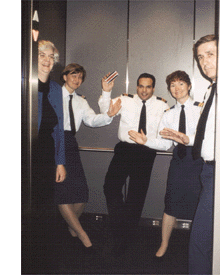Issue 1/03 – 29 January 2003
DHRRE: Matchmaking, CF style
The Directorate of Human Resources Research and
Evaluation's (DHRRE's) Personnel Production section
is responsible for developing and maintaining the aptitude tests
and selection protocols used by the CF in matching applicants with
suitable career paths.
 DHRRE's
Personnel Production section: Leesa Tanner, left, Capt Joy Klammer, DHRRE's
Personnel Production section: Leesa Tanner, left, Capt Joy Klammer,
Lt(N) Mike Vanderpool and Capt Lee Boes (Research Officers), and
Section Head LCol Rick Boswell. Missing: Fariya Syed (Research Officer).
By CFPN
CF Aptitude Test
New Centres
CF Contact Survey
The CFCS provides a systematic measure of attitudes,
motivations and trends within the potential applicant population
(prospects) that could impact the recruiting system. CFCS response
analysis allows Personnel Production section researchers to monitor
factors that could impact the recruiting system. The CFCS has been
modified slightly and is now called the CF Prospect Survey.
The most recent analysis of the CFCS focused on information
from prospects who completed the survey between June 2000 and June
2001. The report, Canadian Forces Contact Survey (CFCS): Look Who's
Coming to Dinner, describes the demographics, attraction influences
and advertising factors affecting these potential applicants.
Results indicate the CF is attracting persons from
the traditional pool of applicants. The majority of prospects are
white males, 14-19 years old, with high school educations.
Advertising had a moderate degree of influence on
their interest in the CF, but the source of information they found
the most influential was a friend/relative with military experience.
Prospects indicated the most recently seen CF advertising was on
television or in a theatre, on posters in schools, and on the Internet.
The most popular reason for seeking employment information was an
understanding that the CF provides career opportunities and challenging
work.
CF Aptitude Test
The CFAT, administered to every CF applicant, is the
primary selection test used to measure general cognitive ability.
The test provides selection standards for both officers and NCMs.
When selecting job applicants on the basis of test
scores, it is critical to avoid bias that may unfairly influence
applicants' scores; selection tests must be fair to all applicants.
A study was launched in 2002, for example, to determine if CFAT
was biased against Aboriginal applicants, and to investigate other
measures that might be better suited to Aboriginal people living
in remote areas. The results of that study will be available in
early 2003.
As well, ongoing studies are recording how well the
CFAT predicts performance. The results of these studies are used
to adjust cut-off scores, ensuring selected candidates have the
potential to be successful in their chosen occupations.
back
MP candidates assessed in new centres
 Historically,
DHRRE has helped the MP Branch select the best and brightest candidates
for its NCM and officer occupations. In 2002, a DHRRE research team,
formed to examine the existing MP selection system to ensure its
viability, decided to incorporate several new assessment tools in
order to combine the best practices of military and civilian police
selection. The team worked to ensure the new centres—the Military
Police Assessment Centre (MPAC) for NCMs, and the Military Police
Officer Assessment Centre (MPOAC)—conform to processes sanctioned
by the International Congress on Assessment Centre Methods. Historically,
DHRRE has helped the MP Branch select the best and brightest candidates
for its NCM and officer occupations. In 2002, a DHRRE research team,
formed to examine the existing MP selection system to ensure its
viability, decided to incorporate several new assessment tools in
order to combine the best practices of military and civilian police
selection. The team worked to ensure the new centres—the Military
Police Assessment Centre (MPAC) for NCMs, and the Military Police
Officer Assessment Centre (MPOAC)—conform to processes sanctioned
by the International Congress on Assessment Centre Methods.
Both centres operate with four main components: assessor
training; candidate assessments; orientation; and a selection board.
Each component is seen as integral to the success of the selection
process. In keeping with International Congress on Assessment Centre
Methods guidelines, assessments are based on competencies deemed
essential to the respective occupations. Assessors are trained to
assess competencies using multiple assessment tools, and several
assessors observe the candidates. No assessor rates any candidate
more than once. Candidates' scores are compiled and combined
to provide a more holistic view.
The new MPAC was implemented in May 2002, and utilizes
a number of tools such as a group dynamics exercise, a role-play,
a structured interview, a background/integrity interview, and a
skills test. The centre is set up so that every MP competency is
tapped at least twice, each time using a different method. The MPOAC
was introduced in October 2002. It, too, utilizes tools including
a group dynamics exercise, two role-plays, a structured interview,
a background/integrity interview, a management issues exercise,
and an
in-basket exercise.
back
Top
|



